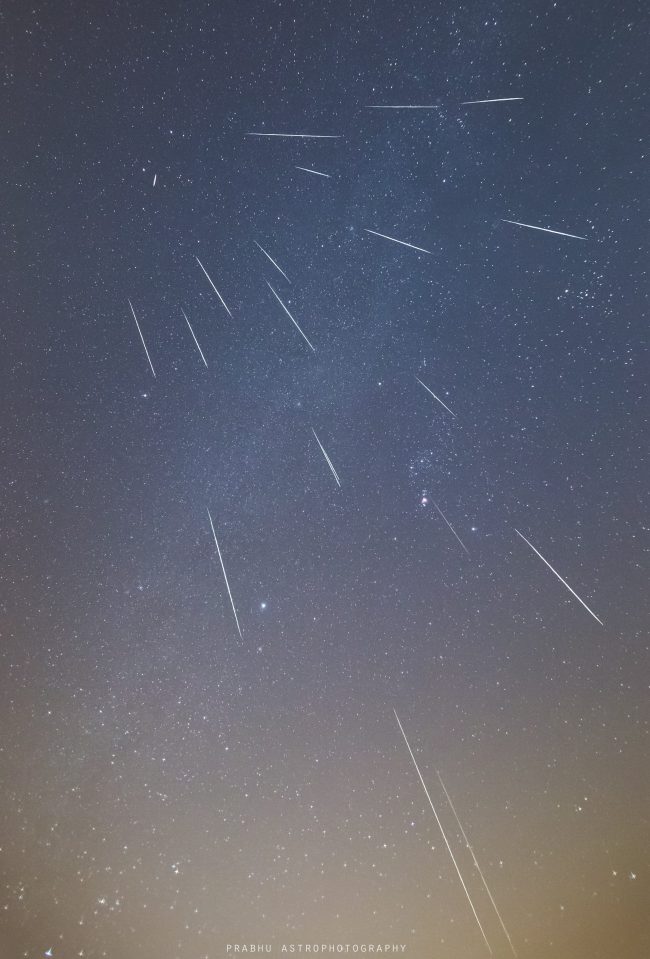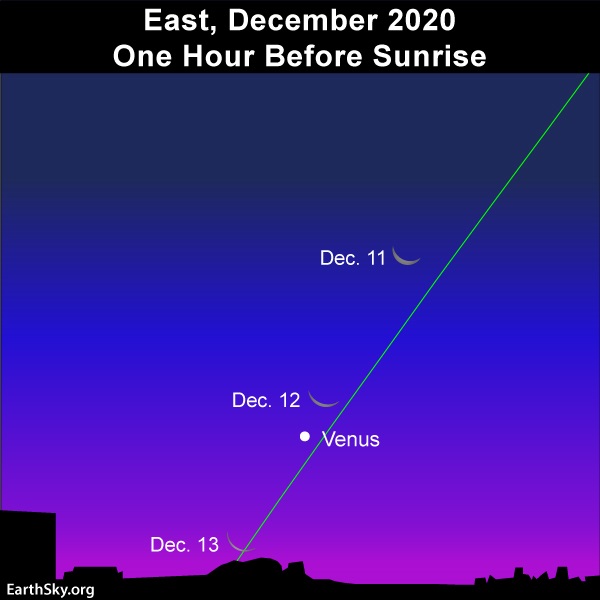
Prabhakaran A captured the images to create this composite on December 14, 2018. He wrote of the 2018 Geminid shower, “I witnessed 200+ meteors, most of them very faint.”
If you had to pick one morning for watching the 2020 Geminid meteor shower, it’d probably be Monday morning, December 14. But Saturday and Sunday mornings might be good as well. At their peak, on a dark, moonless night, the Geminids have been known to produce 120 meteors per hour – or more – in the wee hours after midnight. Any and all meteors are fun to see! Plus, the moon is at and near the new phase for this year’s shower, giving us a dark, moonless sky for this year’s Geminid shower. Not sure where to watch? Try EarthSky’s Best Places to Stargaze page.
Not sure how to watch? Here are 10 tips.
The lunar calendars are here! Order yours before they’re gone. Makes a great gift.
1. Watch late night to dawn. Geminid meteor numbers tend to intensify as evening deepens into late night, with the greatest number of Geminids likely falling an hour or two after midnight, when the meteor shower’s radiant point appears highest in the sky as seen from around the globe. That time holds true no matter your time zone.
2. Get away from city lights. For optimum viewing, find a dark place to observe in the country.
3. Give yourself a wide-open view of the sky. A farmer’s field? A stretch of country road? A campsite with a clear view in one or more directions? An open sky will increase your chances of seeing some meteors.
4. Watch for an hour or more. The 2020 Geminid meteor shower will be better if you let your eyes adapt to the dark. That can take as long as 20 minutes. Plus the meteors tend to come in spurts, followed by lulls. Be patient! You’ll see some.
5. Don’t worry about the radiant point. You don’t need to look in a single direction – or locate the Geminid’s radiant point – to have fun watching the shower. The meteors will appear all over the sky. The radiant point is interesting, though. If you track Geminid meteors backwards on the sky’s dome, you’ll find them streaming from this point, within the constellation Gemini the Twins. Hence this shower’s name.
Read more: Find the Geminids’ radiant point
6. Watch for the moon and Venus. In December 2020, there’s no moonlight to ruin the show. New moon is December 14. But – in the weekend mornings, just prior to the Geminids’ peak morning (also December 14), you can catch the waning crescent moon moon and Venus in the east before sunup. They would be a grand way to end a meteor shower!

As the predawn darkness begins to give way to morning twilight, watch for the waning crescent moon and the dazzling planet Venus rise into your eastern sky. What a wonderful way to cap a night of meteor watching!
7. Think about the Geminids’ parent object. Most meteors in annual showers originate in comets. But the parent of the Geminid meteor shower is a mysterious body named 3200 Phaethon. This solar system object is termed an Apollo (near-Earth) asteroid, and it might be a dormant comet. How does that help you watch the shower? It doesn’t. But it’s fun to contemplate on a dark night under the stars. Read more: Mysterious rock-comet 3200 Phaethon.
8. Bring along a buddy. Both of you watch different parts of the sky. If one of you sees one, shout out “meteor!” Again, don’t worry about which direction to look. Just let your eyes rove casually in all parts of the sky.
9. Special equipment? Not necessary. You only need a dark sky, a reclining lawn chair and the warmth of a sleeping bag. A hot drink and a snack can also be good.
10. Enjoy nature. As a wise man once said, meteor watching is a lot like fishing. You go outside. You hope you catch some!
Bottom line: We anticipate 2020 will be a great year for watching the Geminid meteor shower! Here are 10 tips.
from EarthSky https://ift.tt/2UwVACc

Prabhakaran A captured the images to create this composite on December 14, 2018. He wrote of the 2018 Geminid shower, “I witnessed 200+ meteors, most of them very faint.”
If you had to pick one morning for watching the 2020 Geminid meteor shower, it’d probably be Monday morning, December 14. But Saturday and Sunday mornings might be good as well. At their peak, on a dark, moonless night, the Geminids have been known to produce 120 meteors per hour – or more – in the wee hours after midnight. Any and all meteors are fun to see! Plus, the moon is at and near the new phase for this year’s shower, giving us a dark, moonless sky for this year’s Geminid shower. Not sure where to watch? Try EarthSky’s Best Places to Stargaze page.
Not sure how to watch? Here are 10 tips.
The lunar calendars are here! Order yours before they’re gone. Makes a great gift.
1. Watch late night to dawn. Geminid meteor numbers tend to intensify as evening deepens into late night, with the greatest number of Geminids likely falling an hour or two after midnight, when the meteor shower’s radiant point appears highest in the sky as seen from around the globe. That time holds true no matter your time zone.
2. Get away from city lights. For optimum viewing, find a dark place to observe in the country.
3. Give yourself a wide-open view of the sky. A farmer’s field? A stretch of country road? A campsite with a clear view in one or more directions? An open sky will increase your chances of seeing some meteors.
4. Watch for an hour or more. The 2020 Geminid meteor shower will be better if you let your eyes adapt to the dark. That can take as long as 20 minutes. Plus the meteors tend to come in spurts, followed by lulls. Be patient! You’ll see some.
5. Don’t worry about the radiant point. You don’t need to look in a single direction – or locate the Geminid’s radiant point – to have fun watching the shower. The meteors will appear all over the sky. The radiant point is interesting, though. If you track Geminid meteors backwards on the sky’s dome, you’ll find them streaming from this point, within the constellation Gemini the Twins. Hence this shower’s name.
Read more: Find the Geminids’ radiant point
6. Watch for the moon and Venus. In December 2020, there’s no moonlight to ruin the show. New moon is December 14. But – in the weekend mornings, just prior to the Geminids’ peak morning (also December 14), you can catch the waning crescent moon moon and Venus in the east before sunup. They would be a grand way to end a meteor shower!

As the predawn darkness begins to give way to morning twilight, watch for the waning crescent moon and the dazzling planet Venus rise into your eastern sky. What a wonderful way to cap a night of meteor watching!
7. Think about the Geminids’ parent object. Most meteors in annual showers originate in comets. But the parent of the Geminid meteor shower is a mysterious body named 3200 Phaethon. This solar system object is termed an Apollo (near-Earth) asteroid, and it might be a dormant comet. How does that help you watch the shower? It doesn’t. But it’s fun to contemplate on a dark night under the stars. Read more: Mysterious rock-comet 3200 Phaethon.
8. Bring along a buddy. Both of you watch different parts of the sky. If one of you sees one, shout out “meteor!” Again, don’t worry about which direction to look. Just let your eyes rove casually in all parts of the sky.
9. Special equipment? Not necessary. You only need a dark sky, a reclining lawn chair and the warmth of a sleeping bag. A hot drink and a snack can also be good.
10. Enjoy nature. As a wise man once said, meteor watching is a lot like fishing. You go outside. You hope you catch some!
Bottom line: We anticipate 2020 will be a great year for watching the Geminid meteor shower! Here are 10 tips.
from EarthSky https://ift.tt/2UwVACc

Aucun commentaire:
Enregistrer un commentaire